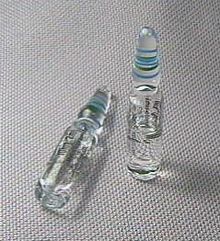
Back أمبولة Arabic Ampula Azerbaijani Ampul·la (recipient) Catalan ئەمپۆل CKB Ampulle (Behälter) German Ampolla (medicina) Spanish Anpoila Basque آمپول Persian Ampoule (récipient) French Ampula Croatian


An ampoule (also ampul and ampule) is a small sealed vial which is used to contain and preserve a sample, usually a solid or liquid. Ampoules are usually made of glass.
Modern ampoules are most commonly used to contain pharmaceuticals and chemicals that must be protected from air and contaminants. They are hermetically sealed by melting the thin top with an open flame, and usually opened by snapping off the neck. The space above the chemical may be filled with an inert gas before sealing. The walls of glass ampoules are usually sufficiently strong to be brought into a glovebox without any difficulty.
Glass ampoules are more expensive than bottles and other simple containers, but there are many situations where their superior imperviousness to gases and liquids and all-glass interior surface are worth the extra cost. Examples of chemicals sold in ampoules are injectable pharmaceuticals, air-sensitive reagents like tetrakis(triphenylphosphine)palladium(0), hygroscopic materials like deuterated solvents and trifluoromethanesulfonic acid, and analytical standards.
Ampoules can be pressurised, have air evacuated from them, and have the air in the ampoule replaced with other gasses, often inert ones. The radio-pharmaceutical Xenon-133 often is packaged in glass ampoules[1] and specially-shaped glass ampoules have long been used for samples of gaseous elements, such as all of the noble gases save radon (mainly because it is radioactive with a half life less than half a week) and special thick-walled quartz and fluorite ampoules under high pressure containing fluorine and chlorine liquefied by the high pressure[2]
Teflon ampoules have been developed, based on the concept of the Teflon jug for high-molarity hydrofluoric acid,[3] for containing chemicals that would corrode and/or ignite glass and/or contaminate themselves, corrode, or disintegrate metal containers where the reagent does not passivate the metal by rapidly forming a layer of a new inert compound on the metal surface reliably and predictably or at all.
Photosensitive chemicals like many 14-dihydromorphinone opioids like hydromorphone and oxymorphone, various silver salts and so on can be packaged in ampoules of smoked glass, glass with chemicals added in manufacturing that filter out ultraviolet and other types of light, or be made with an opaque top and bottom (usually painted with opaque paint) and the rest of the ampoule wrapped in thick paper.
- ^ Veal, N. (1 June 1965). "The handling and dispensing of xenon-133: Gas shipments for clinical use". The International Journal of Applied Radiation and Isotopes. 16 (6): 385–387. doi:10.1016/0020-708X(65)90023-2. PMID 14327645.
- ^ "Pressurized ampule, a sample of the element Chlorine in the Periodic Table".
- ^ "The acid that really does eat through everything". the chronicle flask. 16 April 2013.[unreliable source?]
© MMXXIII Rich X Search. We shall prevail. All rights reserved. Rich X Search